Fly Fishing Questions. The Best FAQs Answered.
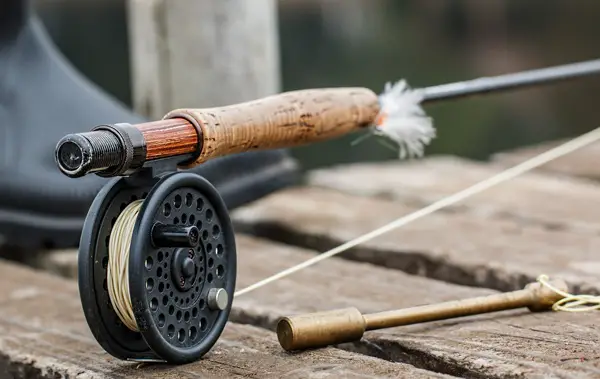
Fly fishing is a fantastic sport and hobby. However, it comes with it’s own unique equipment and techniques, so there are plenty of questions about what, where, why and how to fly fish.
In this article we will cover the popular fly fishing questions or FAQ (frequently asked questions) for short and give plenty of tips, answers and information on fly fishing.
What is the difference between fly fishing and regular fishing?
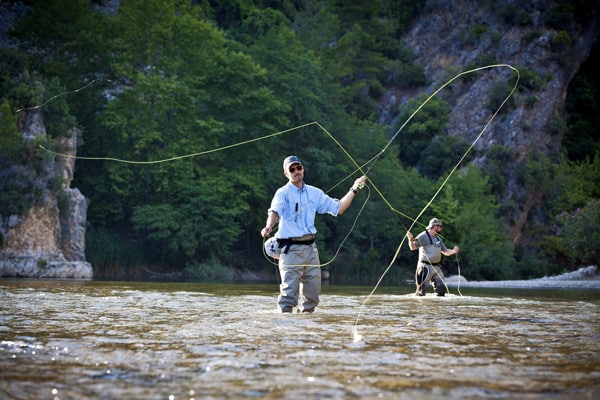
In regular fishing the rod is used with a sinker or float to cast out and the hook, which will have bait like earthworms on it. The bait it will be left out in the water until it catches a fish or the fisherman checks the bait.
With fly fishing the fisherman uses a long fly rod and the fly line is the weight that helps cast the fly. Instead of bait on the hook, an artificial fly is used that might imitate an insect or small baitfish.
The fly fisherman continually works the fly by letting the fly drift, or is continually retrieving the fly in, like a spinning lure.
Once retrieved in, the fly line is then false cast in the air around three times to get more fly line out and the last cast it is cast back onto the water.
For information on fly fishing gear combinations for beginners, click on Best Fly Rod And Reel For Beginners.
What is a false cast in fly fishing?
False casting is when the fly line is picked up from the water and then cast horizontally in the air whilst trying to get more fly line out, before casting the line back into the water.
For additional terms and acronyms visit – Fly Fishing Terms.
What is the advantage of fly fishing?
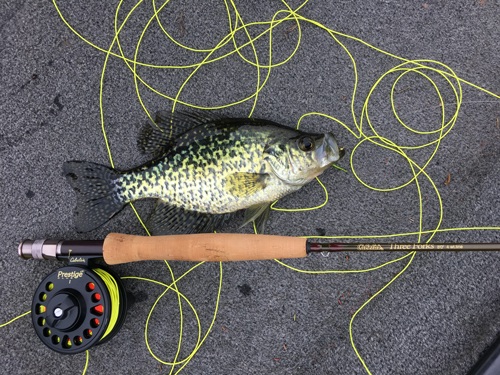
If a fish rises, the fly and line can be picked up, changed direction and cast in front of the feeding fish quickly.
Another positive is you can also quickly change your fly type to imitate what the fish is eating, or match the hatch as they say. An example is if the fish are feeding on beetles on the water’s surface, you can change your fly to imitate a beetle.
With bait fishing you might only have one type of bait which doesn’t match what the fish are feeding on.
When fish like trout are actively feeding on the surface, you can use a dry fly (With bait fishing it is harder to do this unless you have bait and set up for surface fishing.)
For weedy lakes and streams with weed just below the surface, you can place the fly on the water surface so you may not get snagged on the surface.
Fly fishing is very versatile.
You can fish different depths of the water by using a weighted fly, such as a bead headed nymph. Or changing to a sinking tip fly line or sinking fly line.
I love bait fishing, but one advantage of fly fishing (or lure casting) is you don’t have to spend time to catch fresh bait like night crawlers, baitfish or craw-fish. I remember a lot of fishing trips with my father, I think we spent more time trying to gather bait like earthworms or dragon fly larva (mudeyes) then we did actually fishing.
What is the point of fly fishing?
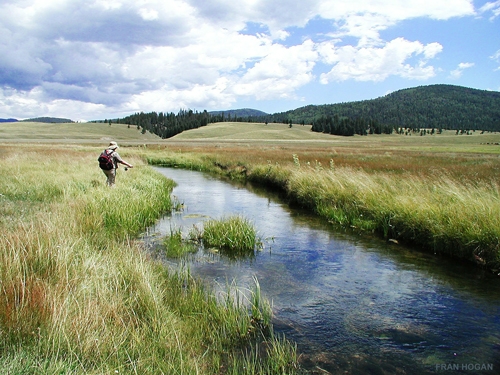
It’s fun and challenging.
Fly fishing can be relaxing and frustrating all in one. It can be a great way to actively hunt fish or just be with nature. It can be done with friends in wild remote places or just at your local lake or stream.
You can chase big trophy trout and salmon to catch and release, or just catch some small pan fish to eat.
The fish species you can target can be either freshwater or saltwater and the variety to catch can be endless.
One reward of fly fishing is that you don’t have to land a trophy to have fun fly fishing as you feel like you deserve the fish as you have actively worked for it. Also with the long responsive fly rod, even a little fish can feel like a battle with a whale on the fly. (Maybe I’m exaggerating a little bit, but it is great fun, regardless of the size of the fish.)
You can tie your own flies, which is a hobby into itself. You can also save money tying flies yourself and get great satisfaction when you catch a fish on a homemade fly you tied.
Is it hard to fly fish?
There can be a learning curve with casting in fly fishing for a start, but with some practice, anyone can do it.
To make it easier to learn, have a friend or fishing club member instruct you.
For the fishing part of learning fly fishing, you just have to have patience. A sense of humor helps as well as when the big fish are in a feeding frenzy all around you that is when you are likely to get tangled up.
What is the best way to practice fly fishing?
For just learning how to cast the fly rod, it doesn’t have to be in or on the water. Go to a flat area, field or oval, with flat grass and plenty of room. (Concrete areas or asphalt can damage your fly line.)
Avoid having trees and shrubs behind you for the back cast, as the hook or line can get snagged up.
Snip the hook off, so there is no dangerous barb or hook, just the shank of the hook. You need a bit of weight on the line, otherwise it won’t cast well.
Practice for a start just doing a roll cast, that is lifting the rod up and placing the line back down, so the fly line rolls out straight.
When you have confidence, just practice casting the fly line horizontal in the air.
On good tip is don’t try and cast too much fly line out at once. Just start with a small length of fly line out first, the once you can handle a certain length of line, try a bit longer length.
Limit your false casts to just 2, 3 or 4 casts. Anymore and you can get tangled up easy.
Avoid practicing fly casting on windy days until you get the hang of it.
Some fluro orange or pink material tied to the shank of the hook, makes it easier to see were you are casting and how accurate you are.
Place a paper plate or Hula-hoop ring and at various distances and see if you can place the fly in the circle.
For more detailed information on learning how to cast the fly rod, visit – How to Fly Fish.
What is a tippet in fly fishing?
A tippet is fishing line tied onto the leader on one end. The other end of the tippet is tied to the fly.
A fly fishing set up for the line would be: backing > fly line > leader > tippet > fly.
Using a tippet saves cutting into the length of the leader when you change flies.
A tippet might be 3 foot or longer, depending on fishing conditions and the angler’s skill.
A longer tippet with a small diameter can be used for shy fish, so the heavy fly line is further away and doesn’t scare the fish.
Some tippet material uses fluro carbon line, as it makes it harder for fish to see in the water.
For more information on what tippet strength and length you need for trout and bass, click on – What Is A Tippet In Fly Fishing?
What is a wind knot in fly fishing?
A wind knot is when you get a knot in your tippet or leader.
It can be from your timing in the casting and it can happen more on windy days.
The tippet material should be checked every so many casts as a knot in the line can weaken the fishing line by half its breaking strain poundage.
If a wind knot is found it should be untangled. Or if it can’t be undone a new section of tippet should be tied on.
What type of flies are their?
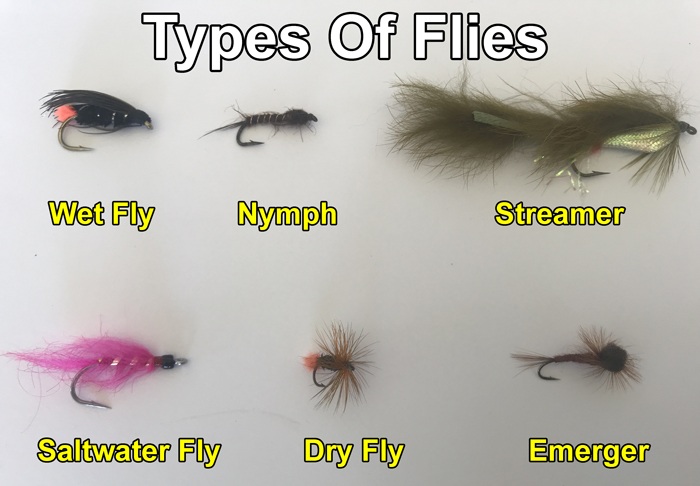
It can vary in parts of the world, but basically fishing flies can be divided up into different types, such as: dry fly, wet fly, nymph and streamers.
Basically a dry fly is fished on the water’s surface. A wet fly, streamer and nymph is fished under water.
Fishing flies could also be broken up further into: 1. Dry flies. 2. Wet flies. 3. Nymphs. 4. Streamers. 5. Saltwater flies. 6. Emergers. 7. Poppers.
See the article on Different Types of Flies For Fly Fishing for more information.
Emergers can sit just under the water’s surface or in between the surface and above, so technically they could be called a dry fly sometimes, depending on design and how they are fished.
Does fly fishing catch more fish?
This will depend on what the fish are feeding on and the angler’s skill.
Sometimes the bait fisherman will out catch the fly fisherman, as bait has the advantage of smell and some natural movement in some instances. Other times the fly fisherman will out fish the bait or lure angler.
The fly fisherman has the advantage of changing the fly to imitate what food is about in the water. Also if the fish are feeding on very small insects like midges, the fly fisherman has the benefit of imitating this small insect.
For very deep fish feeding, like some deep lakes and some saltwater species, the fly fisherman won’t be able to fish very deep and a bait fisherman or deep trawling with lures will catch more fish.
Overall I wouldn’t say one is better than the other, but they are different tools that can be used in different situations.
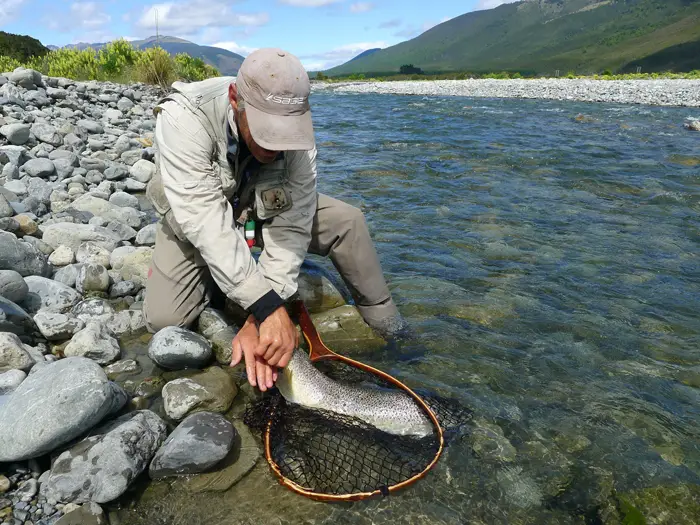
What is the best time of day to fly fish?
For a lot of fish species like trout, bass and salmon, they feel safer feeding in shallow waters in the dark away from the birds and other predators. Some fish come out of hiding around dusk and feed until dawn, so dusk and dawn can be good fishing times in the shallows for the fly fisherman.
Also the warmth of the new daylight can get the insects more active, and also on a warm evening. So dawn and dusk again can be a great time to fish.
Regardless of night or day, fishing around cover and substrates like weed beds, rocks, drop offs, old pier, reefs, fallen timber, outlets, dam walls can be more productive. As the fish have cover and food around these places.
Night fishing can also be very productive for the fly fisherman with some local knowledge of the waters. See the Night Fishing article for more information.
Generally night time, dusk and dawn are better fishing times then the middle of the day. But, this will depend on the weather, season and food available.
Is it hard to tie flies?
No, if you start with a few basic fly patterns and instructions it isn’t complicated. A simple nymph pattern or wet fly pattern is good to learn on.
Some of your first flies may not look pretty but you will advance in your skill and they will look more like a real insect or food form.
When you have mastered some easier flies. You can then progress to harder patterns like dry flies with hackles and advanced streamers.
Fly fishing clubs can have monthly or weekly fly tying lessons. Fly fishing books and YouTube also have plenty of tutorials on how to tie flies.
Can you get your fly reel wet?
Yes, sometime it is unavoidable and the reel takes a dunk in the water or it gets splashed. When you reel the fly line in it will get wet a bit. However, try and limit the amount it gets wet.
If it does get fully soaked, you can rinse it in fresh water and let it dry before storing it.
For using it in saltwater, wash the reel and let it dry after each fishing trip.
How Do I Clean A Fly Fishing Line?
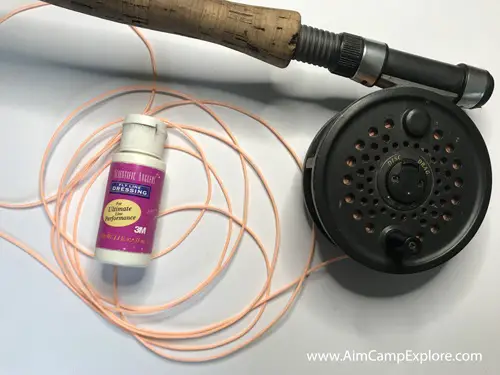
To learn what is the best way to clean the fly reel, visit my article on – How Do I Clean A Fly Fishing Line? Which also covers how to clean a fly reel and fly rod.
What size fly rod do I need?
Generally the smaller the fish targeted, the smaller the number the fly rod and fly line needed. For small trout and pan fish in small ponds and streams, a 3 weight fly rod might be used.
For medium size fish like trout in bigger rivers and lakes, a 5, 6 weight, or even a 7 weight rod might be used.
Casting large poppers for bass fishing or big streamers for salmon, then an 8 weight fly rod might be suitable.
For larger fish for saltwater fly fishing, an 8 weight or larger fly rod might be used.
For shark and marlin a big 12 weight fly rod might be used.
A local fly fishing store or fishing shop will be able to point you in what size tackle you need for your local conditions and fish species.
What do the numbers mean on a fly rod?
The fly rod can have two numbers on it or several.
Generally the rod might read something like 6 w 9’
Or it might read, 9 6 wt.
The number 9’ is the length of the fly rod. In this case, such as the 9’ indicates the rod is nine foot long.
The other number on the rod means the weight of the fly line you should use for the rod. Such as for a 6 w means it matches a 6 weight fly line.
Depending on your fly rod design and action, a fly line one size above or below the recommended number might work as well.
As an example you might be able to use a 5 weight fly line on a 6 weight fly rod. This might be better for timid trout where you need a lighter fly line, presenting the fly on the water so you don’t spook the trout. Or perhaps your rod just casts a heavier or lighter fly line better than the manufacture recommends.
You might even have a rod that reads 9 6/7 wt, which means the length is 9 foot. Also you could use either a 6 weight, or a 7 weight fly line on the rod.
When reading the numbers, be mindful, some rod manufactures might have the rod name or model and actual weight first, which can be confusing for the beginner.
What length are fly rods?
Fly rods can be 7 feet in length for the lighter weight rods. An average length for a fly rod today is around 8 ½ to 9 feet long. With 9 feet being common for a lot of fly fisherman.
10 foot and 11 feet fly rods are becoming popular for nymphing.
A two handed fly rod used for salmon fishing, like a Spey rod may be 12 to 15 foot long.
How to choose a fly line.
Visit this article on How To Choose A Fly Line which covers not only the fly line weights, but also information on function, taper designs and floating and sinking style fly lines.
What is an 8 weight fly rod used for?
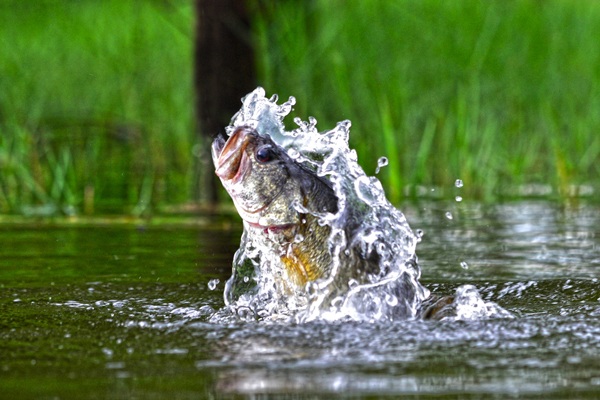
An 8 weight can be used for saltwater fly fishing. Also for salmon and chasing large trout in windy areas, like large lakes.
The 8 weight is also ideal for fishing for big bass, as the heavier line allows you to cast large poppers and big streamers.
Why does fly fishing work?
For fly fishing to work, the fish has to strike the fly. The imitation fly should look, or behave like a food source to the fish.
The fly could be tied of feathers, fur or other material that fished in, or on the water can move or behave like food to entice the trout to eat it.
Some materials like rabbit fur or marabou feathers when used on a fly, can pulsate and look alive when jerked through the water. It can look like a leech, crawfish, frog or baitfish moving, depending on how it is tied and fished.
A dry fly can be tied out of feathers and the hackle helps it sit on the water. When the wind or current drifts it across the water, the fly looks like an insect moving or trapped in the water’s surface.
Some flies like poppers give off a lot of movement and vibration when retrieved quickly on the water. Bass and other predatory fish can aggressively take it, thinking it is a food or another fish invading their territory.
Can you use flies on a normal rod?
Yes you can, however you wouldn’t false cast a normal rod though like a fly rod. You need a weight on the line to help you cast it out. A bubble float or a small sinker can help you cast it out.
You can also let the river current or wind take the line and fly out without any weight on the fishing line.
A fly suspended under a bubble float and retrieved can catch fish. You can also keep the bubble float out in the water and on a windy day the wind or waves can impart movement on the fly, which can attract fish.
Generally though bait might be better choice, as it also can have smell. If you don’t have any bait though a fly used with a float can work.
Do you use bait when fly fishing?
No an artificial fly is used, otherwise the bait would fall off with repeated casting. The fly is made out of feather, fur or synthetic materials to mimic the bait or food living in the water.
What are the best two fly nymphs to fish for trout?
For me I like the plain black nymph. The material for the body is normal seals fur or artificial seals fur. (Sometimes I tie the tail and thorax or head with peacock herl.) I use silver flat tinsel for the ribbing.
Also a gold bead head (or silver bead) nymph with a black body is good for getting deeper down or quicker when there is a current.
These two basic nymph patterns can be effective in a lot of fishing conditions and waters. They have caught me plenty of trout, so you don’t have to get too fussy or complicated in design. Just have a few different sizes in each one.
What tippet poundage should I use to fly fish for trout?
This will depend on the average size of the trout around in your area.
The tippet strength will also depend on your skill and the fishing conditions as well. Such as if you get wind knots. These reduce the breaking strength of the fishing line.
Or if there are plenty of submerged timber around or snags, you might constantly get snagged and broken off and need a heavier tippet strength.
For windy days a heavier tippet might be more suitable for better control of the fly.
Fly size is also important, if you use larger flies or streamers, then go for a heavier tippet.
Around 5 to 6 pounds should work for most fly fisherman depending on the fish species targeted.
If you have large trout in your waters you might have 6 pound tippet on, or heavier.
For spooky fish, a smaller diameter longer tippet of around 4 pound could be used
For fishing midges, a 4, or even 3 pound or even lighter tippet might be used.
When night fishing you might go to a breaking strain of around 8 pounds for bigger trout.
What weight do I need to fly fish for bass?
An 8 weight fly rod / line is a good general size for some bass flies.
While you can cast bass flies with a 6 weight or 7 weight, the 8 weight is better suited for bigger streamers and poppers.
For windy areas, like open lakes the heavier line helps cut into the wind.
Does fly fishing actually work?
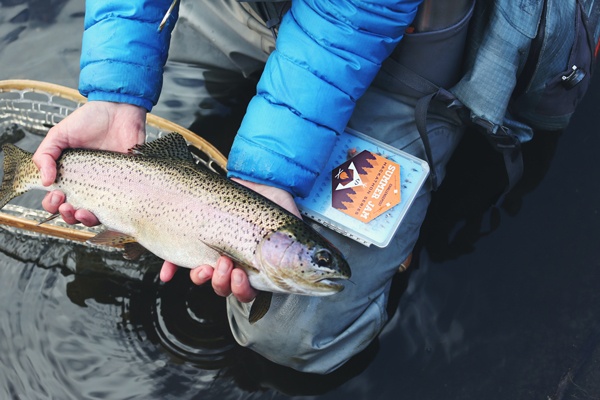
Yes, when the fish are actively feeding, it can be a very deadly fishing technique.
As an example if the fish are locked on to feeding on mayfly’s (otherwise known as duns or March browns) the fish may not take any bait like Powerbait or earthworms for normal fishing. But an imitation mayfly presented with the same size and movement can work in catching fussy fish.
What is a dry fly in fly fishing?
A dry fly is fished on top of the water’s surface. It might imitate an insect that has landed on the water, or trapped on the water’s surface. The fish, like a trout comes up to the surface and takes it, thinking it is food.
Some dry flies imitate insects and food like: Mayflies, beetles, caddis moths, damsel-flies, ants, frogs, midges, grasshoppers, spiders, crickets, etc.
Dry flies are normally fished by drifting them naturally with the wind or current. Any unnatural movement and the fish may not take the fly.
The dry fly can be applied with fly floatent gel to make it float higher on the surface. You can also false cast the dry fly, to dry it out so it doesn’t get waterlogged and sink.
An effective, fun and addictive way of dry fly fishing is Polaroiding. In clear waters you can observe the fish by using Polaroid sunglasses and a hat, you cast the dry fly in front of the fish and watch the fish rise up and take the fly.
It’s exciting and hard not to strike the fish too early as the fly may not be in the fish’s mouth.
Do you really need an expensive fly rod?
No, you don’t need an expensive rod for beginners when learning fly fishing. It is actually advisable to get a low to medium price rod, but reasonable quality fly rod for a start.
(I am not talking about a no name cheap brand rod. As if it too low quality it won’t cast very well and might make casting harder. Also it won’t be very durable and break with too much strain on it.)
If you buy and expensive rod, you might buy the wrong size weight rod or length for your fish species or areas you fish in. So it is advisable not too buy an expensive fly rod for a start.
Also you may not even enjoy fly fishing, so there is no sense buying the most expensive, best fly rod available if you are just starting out.
When you get more experienced, than perhaps a top of the line fly rod is worth looking at later on.
There are plenty of quality brands like Orvis, Sage, Fenwick, Scott, Loomis, Thomas & Thomas, Penn, R.L. Winston Rod Company, Hardy, Redington, etc. that make some of the best fly rods in the world and these companies have a wide range of models in different price ranges.
A fly rod, fly line and reel kit from Orvis or another brand name fly fishing company like above can be a good start.
Do you have to use a fly rod to catch trout?
No, you can use any normal rod with bait, or spinning lures to catch trout.
Can you use a spinner on a fly rod?
Generally not, the weight and size of the spinner and aerodynamics of it makes it hard to cast. Also if the metal spinner hits the fly rod, it can damage the carbon fiber rod or break it.
If you were drifting in a boat, or fly fishing from a kayak you could use a fly rod to troll the spinner behind, but it wouldn’t have a great exciting action like when retrieved with a spinning rod.
Can you put a worm on a fly rod?
You can, but with the repeated casting, the earthworm will soon fall off.
The only real way to fish it is if you let the river current or wind behind you on the lake, take the fly line drift out with the worm on it. You then fish and leave the line out like a bait rod.
Here is how you might use the worm on a fly rod: If you are fly fishing and stop fishing for lunch, you might find some worms underneath a log. You can then put the worm on the fly and let it drift out (wind or current) and fish, while you are having lunch and watching the rod.
What can I catch with fly fishing?
Almost all species you can catch with a normal fishing rod, you can catch with a fly rod. The exception is deep sea fish that feed and live close to the bottom that are out of the reach of the fly rod.
Some pelagic fish that swim deep in the ocean are hard to catch unless they are feeding close to the surface.
Small pan fish to large game fish can be caught with fly gear.
The type of fish can you catch on a fly rod is endless, from bass, crappie, grayling, bonefish, a variety of trout and salmon, to tuna, sharks and sailfish.
Does fly line spook trout?
Yes it can scare the trout if it is too close to the moving fly line or in clear waters. Ideally you want to present the fly on the water correctly without scaring the fish.
You don’t want to smack the fly line down hard down on the water, otherwise it can scare fish like trout.
For cautious trout, a longer leader and light long tippet can help prevent scaring the fish.
(There are some fish species or conditions were slapping the fly line down hard on the water can attract the fish like in rough, dirty water. However, you don’t want to land the fly line on the fish’s head and scare it away.)
Some fly fisherman will run a new fly line through the mud so it isn’t too reflective and shiny on calm and clear waters.
Can you put fly line on a spinning reel?
No, it won’t work well as the fly line is heavy and thicker than normal fishing line. Physically you can do it, but it won’t cast well.
Can you fly fish all year round?
This will depend on your fish and game regulations and season.
Also some fish species aren’t as active and are dormant at certain times of years. They don’t feed as regular, therefore can be harder to catch.
Also fish can go into deeper waters, or migrate in different season so they can be non-existent in a previous fishing spot.
If you are legally allowed in your state or water course and the fish are about, then you can fly fish all year round.
Can you fly fish in both salt and freshwater?
Yes, you can fly fish for in both saltwater and fresh.
A heavier weight fly rod and fly line might be used for the bigger saltwater species.
What color fly line is best?
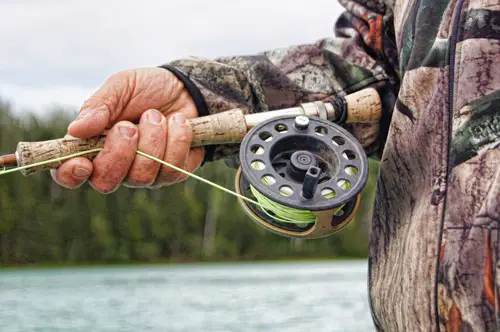
A sinking line will normally be a dull color like grey or brown as this is designed to go deeper down. In deeper water the light reduces and the color fades.
For floating lines on the surface an off white color or bright color might be used. One theory is when a fish like a bass or trout look up towards the water surface and sunlight, a floating light colored line like ivory will blend in better and be harder for the fish to see.
A benefit of a bright color fly line is it makes the line easier to see for the angler. He or she can see what the fly line is doing and mend the line when drifting nymphs, or dry flies, etc.
For beginners a floating line might be as it is easier to see where the line is both on the water and also when learning how to fly cast or false cast in the air. If you fish at dusk and dawn, visually seeing where the fly line is on the water is a great help and gives you confidence.
For dry fly fishing when drifting with the wind or current, where the line is and what it is doing is important to see. Otherwise it could be dragging your artificial fly in the water and not looking like a natural movement of an insect on the waters film.
For beginners don’t get to hang up on colors though, just practicing on casting and presenting the fly accurately. Otherwise even if your line is camouflaged, the fish will swim away if it is whacked on the head with the badly cast fly line.
Do you fly fish in a lake?
Yes, you can fly fish in a lake, either from the bank, boat, kayak or canoe. Visit – Difference Between Kayak and Canoe for more information about the two.
Fish around structures like: weed beds, inlets and outlets, dam walls, submerged timber, jetties and rocks. These areas provide shelter and food for fish.
Depending on the depth of the lake, you might need a sinking fly line to get down deep. For dusk, dawn and night time fishing, bays and shallow flats can attract fish as the fish come in to feed in low light.
Can you fly fish from a boat?
Yes you can fly fish sitting or standing in a boat. You do have to be careful that your back cast doesn’t hook any equipment or people though.
You can fly fish from a kayak, canoe and float tube as well. Click on Best Float Tubes For Fishing for more details.
Does fly fishing catch smaller fish?
You can catch large fish or small fish with fly gear, depending on what fish species and size of the fish are about.
The beauty of fly fishing is you can target small species of fish and use light delicate tackle to catch them.
Fly fisherman and fly fisher-woman have caught huge trophy size bass, trout and salmon on fly gear.
Marlin and even shark can be caught when saltwater fly fishing.
Why is fly fishing line heavier than mono?
In fly fishing you don’t use a sinker to help cast the fly, but the fly line is weighted through the length of it to help cast the fly. The actual fly line helps turn over the leader and tippet and present the fly delicately on the water.
Can I fish in a creek with a fly rod?
Yes, you can fly fish in a creek.
You have to use a very light poundage tippet and small flies. You might use a 2 weight fly rod and line for small creeks and fish.
A common size is a 3 weight fly rod for creeks and small fish species.
If you are going to use the fly rod for bigger rivers and lakes as well, then a 5 weight rod and fly line might be preferred. (As you can put on a long small diameter tippet when fishing small creeks if you don’t want to have two fly rod set ups.)
What is fly fishing backing line?
A fly line is relatively short at around 80’ (24.4m) or a bit longer. So if a big fish runs the fly line out longer you would end up breaking off the fish. So fly line backing is attached to the fly line so you have more length of line when fighting the fish.
Also strong currents and tides can also help the fish have powerful runs that can strip the fly line off, so backing is a good idea for saltwater fishing or strong rivers.
As well as length advantage, the fly line backing also fills up the spool more and the fly line has a larger diameter to pack on when winding. This wider diameter helps reduce memory and squash the fly line that would be on a smaller diameter spool.
Fly line backing normally comes in 20, 30 or 50 pound strengths.
What are fly fishing streamers?
Streamers are bigger wet flies used for salmon and chasing bigger trout. They are normally made with layers of feathers and are bright and big flies.
Streamers can imitate food like bait fish. (Fry or smelt.)
How does fly fishing line work?
With a normal rod, a weight like a sinker or bubble float is used to cast the fishing line and hook out. With fly fishing, the weight of the fly line helps cast it, or shoot it out.
With one false cast you might get a few feet of fly line out, the second false cast a few more feet of line out and for the third cast you shoot out a few more feet of fly line and lay it on the water.
The fly line turns over the leader and tippet and it presents the fly nicely on the water.
How to identify fly fishing flies.
Artificial flies are normally made of feathers, fur and artificial materials. These are layered on the hook to give it appearance like a terrestrial insect, aquatic insect, baitfish or other food source.
Most lures will have treble hooks, while most artificial flies have one hook. (The exception is for some salmon streamers with treble hooks.)
Most fly fishing flies are small, compared to a hard plastic lure. With the exception of large fly fishing streamers used for large salmon, bass poppers and saltwater flies can also be large.
With a lure, it will have a bib to help them deep dive. Normal fishing lures can be made out of hard plastic, soft plastic and spinner baits out of metal. While you can get some flies made of parts of these, most flies are soft materials.
What is the best way to carry fly fishing gear?
A fly fishing vest makes it easy to carry fly gear like: assorted fly boxes, spare spools, extra tippet material in different poundage’s, fishing line nippers, knife and polarized sunglasses, etc.
I have used shoulder carry fishing bags and haversacks many times before fly fishing vests become popular. The fishing bags are a cheap and easy way to carry fishing tackle. One issue with them is, you might be waist deep in the water and they can hang low and get wet in the water. Also they can get heavy on one shoulder. You can place it on the bank when wading, but if you wading up or down the stream or bank, it is inconvenient to continually retrieve it.
If you are starting out and don’t know if fly fishing is for you, just use your back pack or a carry bag. After a few trips when you know that fly fishing is for you, then look at a fly vest.
What is the best way to carry fly fishing net?
Fishing nets can come in a few designs such as a short handle net, or a collapsible fishing net.
You can carry these nets a couple of ways, one is to clip the short net up high on your back on the fly vests. Two disadvantages of this is; if your fly vest has storage room for gear in the back, the net can get in the way. Also it can be hard to get too quickly and swing on your back if the handle is too long.
A fishing lanyard net cord can help you retrieve it quicker.
Another way to carry is to clip the net on your belt. The advantages of this is that it is easy to get while you are playing a fish. The disadvantage is that it can swing and get in the way when walking. It can also collect weed when wading in the water.
You can get collapsible nets that have a sheath or pouch you can put them in and they go on your thigh or hip.
Can you fly fish in the rain?
Yes, with light rain it is rather pleasant fishing in the rain.
Too heavy rain can make it hard to see if any fish are rising feeding and can put the fish down. However, they still might be feeding underneath on aquatic insects or food.
How to reel in a fish on a fly rod?
With fly fishing tackle you can reel in the fish two ways. One, is with the normal fly reel of winding the fish in.
The second way is you can play the fish by hand, that is stripping and pulling on the fly line in by hand. The excess fly line isn’t wound in on the fly reel but stripped in.
One negative of playing the fish by hand is the excess fly line can be at your feet and get tangled on sticks or itself. When the fish runs, the line can tangle and get caught in the runners and hence the fish breaks off.
Also rocks can abrade the fly line on the ground or you can step on it in the excitement of playing the fish.
Where to start fly fishing?
Fly fishing shops near you can be a great source of local fishing knowledge. Both in equipment and where to go to.
Fishing Forums, parks and wildlife rangers, fishing clubs can be a wealth of information on where to go fishing for beginners.
For tips, hints and techniques, click on – Fly Fishing Tips and Tricks.
Also for more information on general fishing, go to – Fishing Tips For Beginners.
Conclusion.
We hope you enjoyed the common fly fishing questions and answers. Thank you for reading and we hope we see you on the river.
For more information on what fly fishing equipment is needed, click on – What Fly Fishing Gear Do I Need?
Extra Resources:
What to Look For In a Fishing Float Tube?

